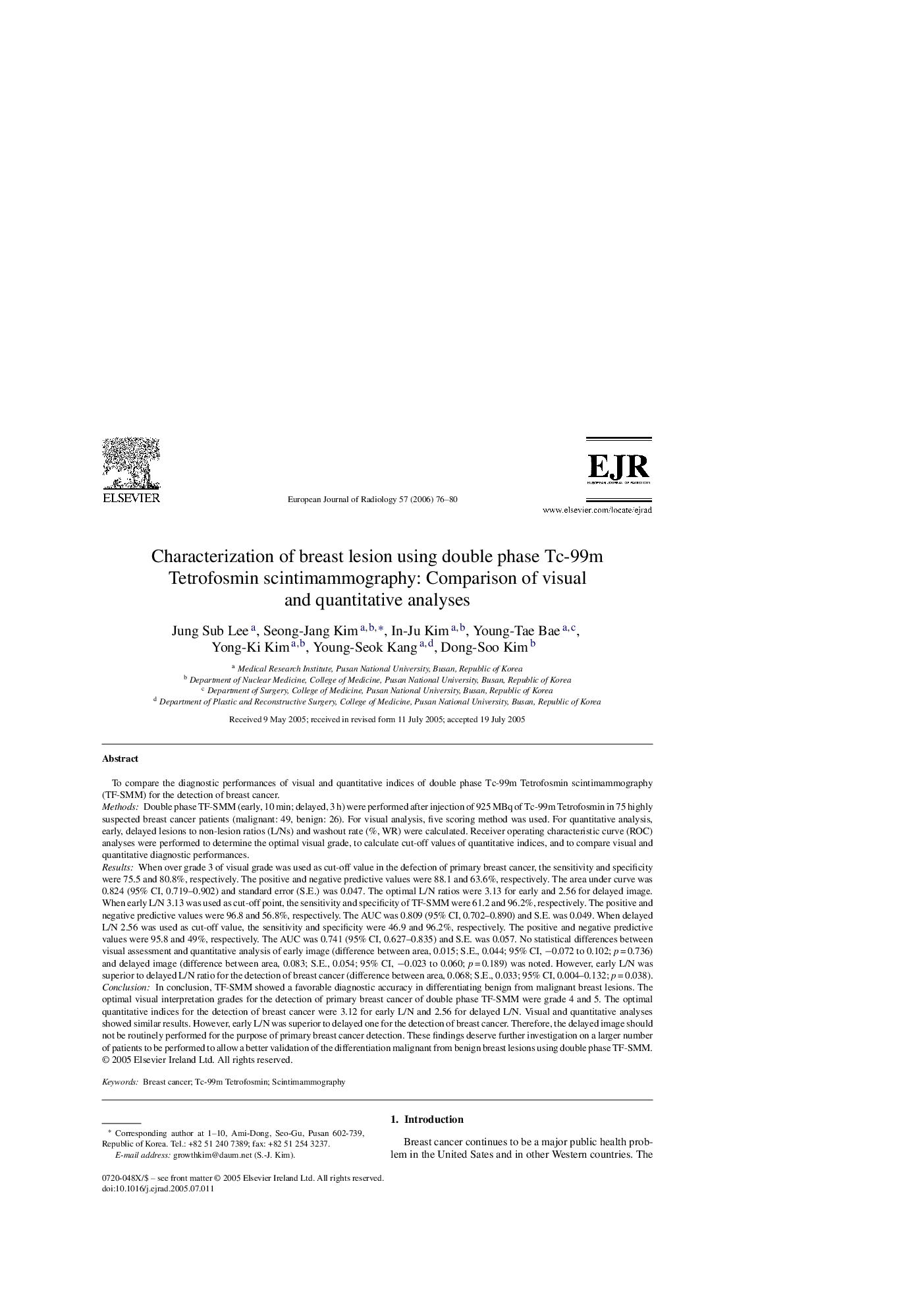| Article ID | Journal | Published Year | Pages | File Type |
|---|---|---|---|---|
| 4228822 | European Journal of Radiology | 2006 | 5 Pages |
To compare the diagnostic performances of visual and quantitative indices of double phase Tc-99m Tetrofosmin scintimammography (TF-SMM) for the detection of breast cancer.MethodsDouble phase TF-SMM (early, 10 min; delayed, 3 h) were performed after injection of 925 MBq of Tc-99m Tetrofosmin in 75 highly suspected breast cancer patients (malignant: 49, benign: 26). For visual analysis, five scoring method was used. For quantitative analysis, early, delayed lesions to non-lesion ratios (L/Ns) and washout rate (%, WR) were calculated. Receiver operating characteristic curve (ROC) analyses were performed to determine the optimal visual grade, to calculate cut-off values of quantitative indices, and to compare visual and quantitative diagnostic performances.ResultsWhen over grade 3 of visual grade was used as cut-off value in the defection of primary breast cancer, the sensitivity and specificity were 75.5 and 80.8%, respectively. The positive and negative predictive values were 88.1 and 63.6%, respectively. The area under curve was 0.824 (95% CI, 0.719–0.902) and standard error (S.E.) was 0.047. The optimal L/N ratios were 3.13 for early and 2.56 for delayed image. When early L/N 3.13 was used as cut-off point, the sensitivity and specificity of TF-SMM were 61.2 and 96.2%, respectively. The positive and negative predictive values were 96.8 and 56.8%, respectively. The AUC was 0.809 (95% CI, 0.702–0.890) and S.E. was 0.049. When delayed L/N 2.56 was used as cut-off value, the sensitivity and specificity were 46.9 and 96.2%, respectively. The positive and negative predictive values were 95.8 and 49%, respectively. The AUC was 0.741 (95% CI, 0.627–0.835) and S.E. was 0.057. No statistical differences between visual assessment and quantitative analysis of early image (difference between area, 0.015; S.E., 0.044; 95% CI, −0.072 to 0.102; p = 0.736) and delayed image (difference between area, 0.083; S.E., 0.054; 95% CI, −0.023 to 0.060; p = 0.189) was noted. However, early L/N was superior to delayed L/N ratio for the detection of breast cancer (difference between area, 0.068; S.E., 0.033; 95% CI, 0.004–0.132; p = 0.038).ConclusionIn conclusion, TF-SMM showed a favorable diagnostic accuracy in differentiating benign from malignant breast lesions. The optimal visual interpretation grades for the detection of primary breast cancer of double phase TF-SMM were grade 4 and 5. The optimal quantitative indices for the detection of breast cancer were 3.12 for early L/N and 2.56 for delayed L/N. Visual and quantitative analyses showed similar results. However, early L/N was superior to delayed one for the detection of breast cancer. Therefore, the delayed image should not be routinely performed for the purpose of primary breast cancer detection. These findings deserve further investigation on a larger number of patients to be performed to allow a better validation of the differentiation malignant from benign breast lesions using double phase TF-SMM.
